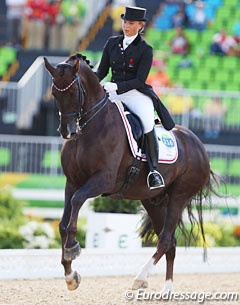
How do you become a consistent rider, but one that doesn’t allow the horse to get bored? How do you teach a horse to respond to clear and concise aids without overdoing it? Nuno Oliveira said that “for all the exercises we must give the horse the clearest notion of what is being demanded from him. Long lasting impressions (which produce submission) are the result of correct actions, always the same. To speak clearly and simply and always in the same manner is one of the secrets of dressage.”
This is the first step: Being a rider who can produce and then reproduce movements, using the same aids and the same amount of pressure. This takes time and thought. Often you see riders trying to achieve something and then reproduce it using different aids. A rider must have, first and foremost, the physical awareness of what they did, and how to do it again, and then the mental capacity to remember it.
My mum used to say “put that in your computer and put it in his computer”. It was about setting up the environment for the horse to remember something and for you to remember how you got it. Then, you must know when to let it go for a while, in order for the horse not to get tired of it.
In dressage, there is no absolute. The aid and pressure I apply on one horse will never be the same on another. To give the horse the “clearest notion” of what we expect from him, is about finding the aids that allow you to balance the horse, and then ask for the movement.
I know that for me, my aids are slightly different to most riders. I know that if I put my leg too far back, my hip can’t cope with the strain, so I tighten, so I have to teach my horse Batialo to respond to a leg that is only slightly back. This is ok. Nuno used to say that you could teach a horse to do a flying change by touching his ear if you wanted to. What he meant was that as long as you were consistent and made the horse understand that that corresponded to a flying change, then you could teach the horse to respond in that way.
The trouble is often riders take consistency too far. They ask for something and then risk it. Then instead of trying to take a step back and understand or even reshape the aid in order for the horse to better understand, they just apply more pressure, and more pressure, until the horse does what they wanted, but through force, not through understanding.
Sometimes you have to let the horse make the mistake, stop, then ask the same way again so that the horse learns that it was not what you wanted. Imagine you ask a flying change by placing your outside leg back and the horse doesn’t understand. Some riders would then keep going in counter canter, with their outside leg banging about until they get the change. This just teaches the horse to only change on a strong leg aid, which will create more problems later.
A good rider will stop. Then begin simple changes reminding the horse that a light touch of the outside leg means canter with the other leg leading. Then try again. Then the minute the horse does the change off a light leg aid, stop reward, finish. This is balanced consistency, knowing when to tell the horse, well done, and asking again tomorrow.
If you, on the contrary, carry on asking more changes, even after the horse has responded the way you wished, the horse will get tired, bored, and resent the change. He will then begin to change badly, or ignore your light aid, and the change will become a movement that he dislikes.
When riders say “oh my horse doesn’t like flying changes”, I always ask myself why? A horse that was taught with consistency, yet reward and a rider who “settled for little” will typically love to show off the flying change and may even at a point do them without asking. For me this is never a bad thing, and a rider simply needs to stop and put the horse back on the leg he was going to remind the horse to wait for him.
The second way to kill a horse's spirit, besides overdoing something, is to punish him when he does the something you were striving for without asking. This is wrong for two reasons. Firstly, we never know exactly what we tell the horse, and the slightest shift in our weight may cause him to think you wanted a change. In his mind he was doing what you wanted, so if you punish him for it he won’t understand, and will be less willing to give it to you next time. Secondly, you want a horse that wants to do things for you. You always need to remind him that it's on your terms, but this should be done as a gentle reminder and not a reprimand.
Always remember in riding, that our aim is to make the horse understand, to help him understand, to reward him the minute he does, and to never make him resent or become bored with anything we teach him. Try to get your horse excited about learning, and you will be amazed at how much harder he tries to understand you.
by Sarah Warne - Photo © Astrid Appels